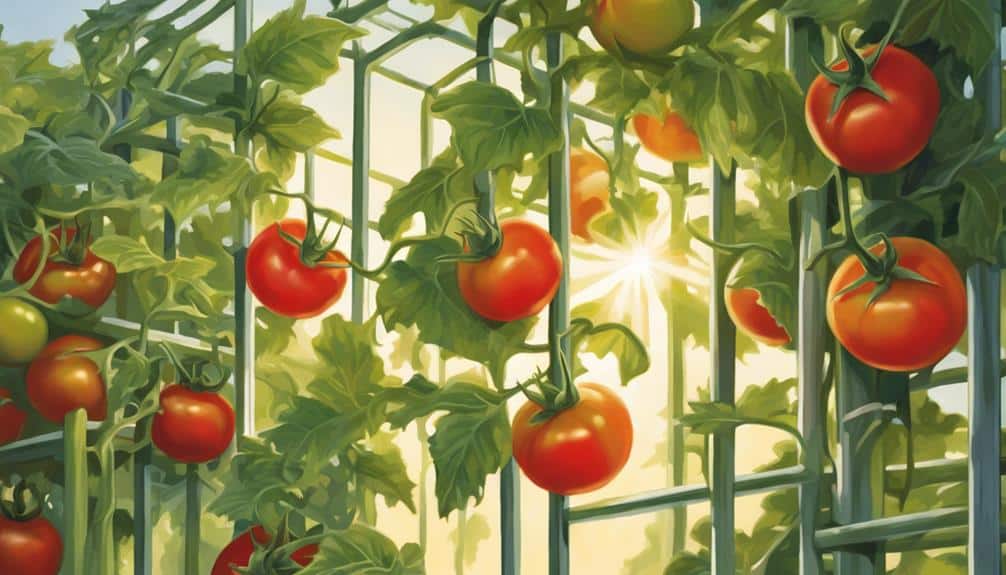To grow juicy, flavorful tomatoes, you'll need to provide your plants with at least 6-8 hours of direct sunlight daily. This full sun exposure is critical for energy conversion, robust development, and fruit ripening. Insufficient sunlight can lead to weak vines, poor fruit quality, and limited yields. By understanding how to balance morning and afternoon sunlight exposure, you'll set your tomatoes up for success. Want to learn more about optimizing sunlight for a bountiful harvest?
Key Takeaways
• Tomatoes require at least 6-8 hours of direct sunlight daily for optimal growth and fruit production.
• Insufficient sunlight can lead to weak vines, poor fruit quality, and limited yields.
• Morning sunlight exposure kickstarts the daily growth cycle, while afternoon sun provides warmth and extends the energy cycle.
• Balancing sunlight and heat stress prevents issues and promotes healthy growth.
• Techniques like pruning, optimizing garden orientation, and using reflective surfaces can increase sunlight exposure for tomato plants.
Defining Full Sun Requirements
What constitutes full sun for tomatoes, and how many hours of direct sunlight do they really need to thrive?
Tomatoes need full sun to produce energy, develop strong vines, and ripen fruit efficiently. You may wonder, what does 'full sun' really mean? Essentially, it means providing your tomatoes with at least six hours of direct sunlight daily. This duration is vital for best energy production, which fuels plant growth, blooming, and fruit ripening.
When you provide your tomatoes with full sun, you're giving them the energy they need to thrive. With adequate sunlight, your plants will develop strong, robust vines, and produce high-quality fruit. On the other hand, insufficient sunlight can lead to weak vines, poor fruit quality, and lower yields.
It's crucial to make sure your tomatoes receive the necessary amount of sunlight to prevent these issues.
Light Needs for Optimal Growth
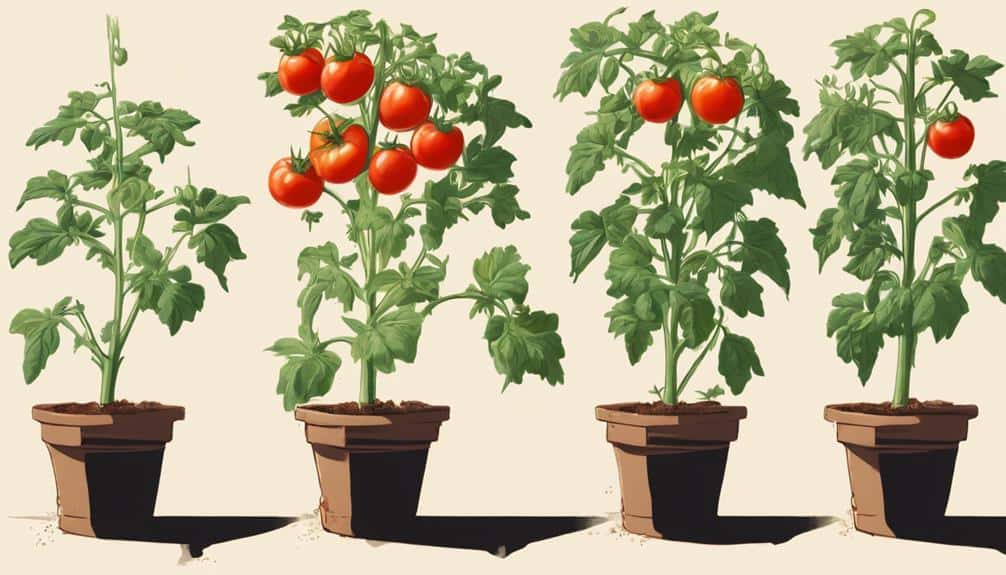
To guarantee optimal growth and fruit production, tomatoes require a minimum of 6-8 hours of direct sunlight daily, which fuels energy conversion through photosynthesis and promotes robust development. As a tomato grower, you need to make sure your plants receive sufficient light to thrive. Inadequate sunlight can lead to weak vines, poor fruit quality, and limited yield. On the other hand, excessive sun exposure during the ripening stages can cause sunscald, cracking, and uneven ripening.
Tomatoes are a sun-loving plant, and their growth is directly linked to the amount of light they receive. When you provide your tomatoes with the required 6-8 hours of direct sunlight, you're giving them the energy they need to convert light into energy through photosynthesis. This process is essential for healthy development, fruit production, and overall plant growth.
Indeterminate tomato varieties, in particular, require 6-8 hours of direct sun for robust growth and fruit development. By providing your tomatoes with the necessary light, you'll be rewarded with a bountiful harvest of juicy, flavorful fruits. Remember, sunlight is vital for tomatoes to reach their full potential, so make sure to plant them in a spot that receives ample direct sunlight.
Understanding Photosynthesis Process

As you explore the role of sunlight in tomato plants, you'll discover that photosynthesis is a complex process that relies on light energy.
You'll find that light-dependent reactions occur in the thylakoid membranes of chloroplasts, where energy from sunlight is converted into ATP and NADPH.
Understanding this energy conversion process is essential to appreciating the significance of sunlight for tomato plants' growth and fruit production.
Light-Dependent Reactions Occur
In the chloroplasts of plant cells, light-dependent reactions occur, where sunlight is absorbed by chlorophyll, triggering the conversion of light energy into chemical energy.
As you grow tomato plants, you need to understand that these vital light-dependent reactions are important for their survival. When you provide your tomato plants with sufficient hours of sun, you're basically giving them the energy they need to thrive.
During these reactions, sunlight is converted into energy, which is then used to fuel the growth and development of your plants. Without sufficient sunlight, your tomato plants won't be able to undergo photosynthesis effectively, impacting their overall health.
As a grower, it's crucial to make sure your plants receive adequate sunlight to facilitate these light-dependent reactions. By doing so, you'll be providing your tomato plants with the energy they need to produce a bountiful harvest.
Energy Conversion Process
You're about to explore the fascinating process of how tomato plants convert sunlight into energy, which is essential for their growth and fruit production.
This energy conversion process is known as photosynthesis, where chlorophyll in tomato leaves absorbs sunlight, converting it into sugars and starches for plant development. As sunlight triggers the opening of stomata in tomato leaves, it allows for the exchange of gases important for photosynthesis.
During this process, tomatoes utilize sunlight to produce oxygen, a byproduct of photosynthesis critical for plant and environmental health. Understanding the photosynthesis process highlights the importance of adequate sunlight for the best tomato growth and yield.
As you investigate further into this process, you'll realize that sunlight is the driving force behind tomato plant development, and its absence can greatly impact fruit production. With this knowledge, you'll be better equipped to provide your tomato plants with the right amount of sunlight, ensuring a plentiful harvest.
Importance of Morning Light Exposure
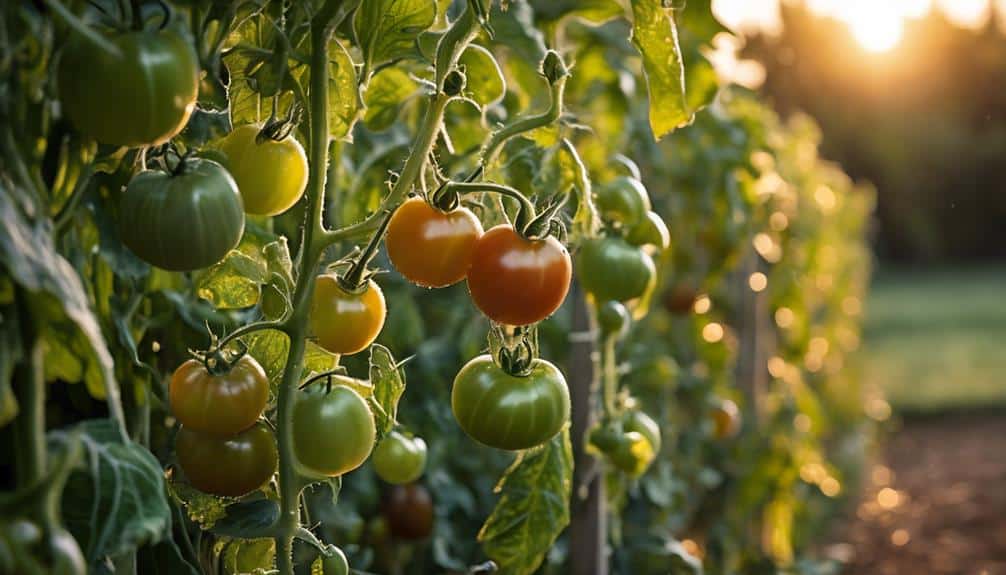
Morning light exposure plays an important role in kickstarting your tomatoes' daily growth cycle, providing a high-intensity light without excessive heat that's ideal for hot climates. As you position your tomato plants to receive morning sunlight, you're essentially giving them a head start on photosynthesis. This is essential for initiating the daily energy cycle and promoting healthy tomato growth. By orienting your plants to receive morning light, you're setting them up for efficient photosynthesis and overall plant health.
In regions with high temperatures, morning light exposure can be more beneficial than afternoon sun. This is because morning light provides the necessary energy for growth without the intense heat that can be detrimental to your plants. By harnessing the power of morning light, you're giving your tomatoes the best chance to thrive. This is particularly important in hot climates, where excessive heat can hinder growth and even lead to scorching.
As you optimize your tomato plants' morning light exposure, you're creating an environment conducive to efficient growth. By doing so, you're allowing your plants to absorb the necessary energy to fuel their growth, setting them up for a bountiful harvest. So, make sure to position your tomato plants to receive plenty of morning sunlight, and watch them flourish as a result.
Afternoon Sun for Tomato Development

How can afternoon sunlight, which brings warmth to your tomato plants, contribute to their ideal development, especially in regions where temperatures drop? The answer lies in the benefits of extended warmth and energy.
Afternoon sunlight provides a boost to your tomato plants, extending their daily energy and growth cycle. This warmth supports the overall health and growth of your plants during the day, making it a crucial component of their development.
In colder climates, afternoon sunlight plays a critical role in maintaining perfect temperatures for tomato development. By providing warmth, you can guarantee your plants receive the necessary temperatures for healthy growth and fruit production.
Balancing morning and afternoon sunlight is key to providing your tomatoes with the required light for excellent development. By doing so, you can create an environment conducive to healthy growth, fruiting, and overall plant development.
As you nurture your tomato plants, remember that afternoon sunlight isn't just a supplement to morning light; it's a vital component of their development. By understanding the benefits of afternoon sunlight, you can create an environment that supports the healthy growth and development of your tomato plants.
Providing Unobstructed Sunlight Hours

To guarantee maximum growth and fruit production, it's vital to provide tomato plants with a minimum of 6-8 hours of unobstructed sunlight daily. Anything less can lead to weak vines and poor-quality fruits. You must make sure that your tomato plants receive full sun, which is critical for their development. Insufficient sunlight can result in weak vines and poor-quality fruits, underscoring the importance of unobstructed sunlight.
It's common to overestimate sun exposure, so regularly monitor sunlight levels throughout the growing season to make certain your plants receive the necessary amount. Plants placed in shaded areas may not yield many fruits or grow well, emphasizing the significance of adequate sunlight. The lack of sunlight can impact plant size and fruit yield, highlighting the necessity of providing tomatoes with enough sunlight for ideal development.
Providing unobstructed sunlight hours is crucial for fruit production, and it's your responsibility as a gardener to ensure your tomato plants receive the required amount. By doing so, you'll be rewarded with a bountiful harvest of juicy, flavorful fruits. Remember, 6-8 hours of direct sunlight is the minimum requirement for healthy tomato plants, so make sure to provide them with the right conditions to thrive.
Ways to Increase Sunlight Exposure
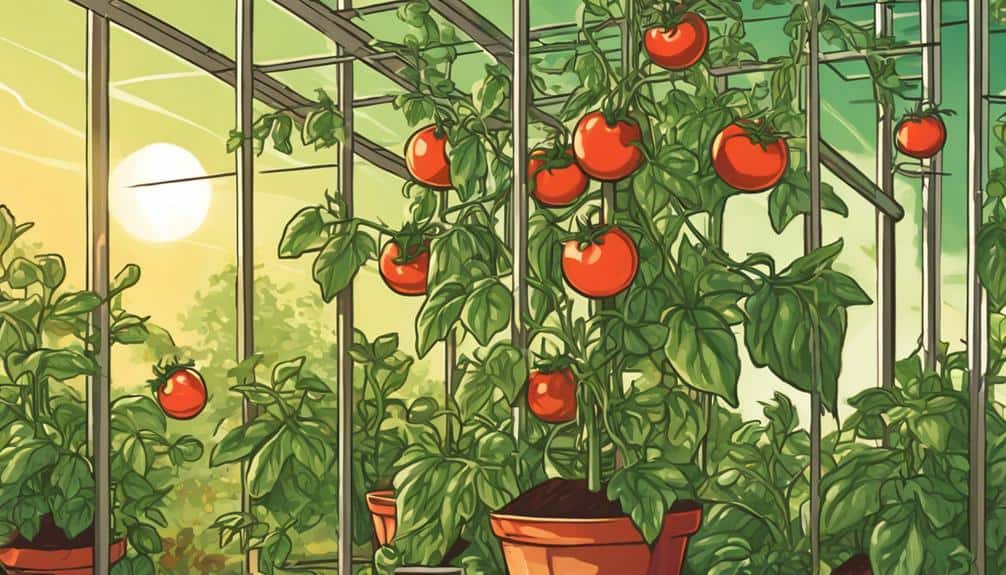
To maximize sunlight exposure for your tomatoes, you'll want to focus on creating an ideal environment.
You can start by pruning shading foliage and optimizing your garden's orientation to receive the most sunlight.
Prune Shading Foliage
By regularly pruning shading foliage, you can greatly increase sunlight exposure to your tomato plants' upper leaves and fruits. This is essential, as sufficient sunlight exposure is vital for ideal tomato growth and fruit production.
To achieve this, remove lower foliage on your tomato plants, as this will allow more sunlight to reach the upper leaves and fruits. Additionally, prune excessive branching to allow more sunlight to reach the central parts of the plant. This won't only enhance sunlight exposure but also promote healthy air circulation and reduce the risk of disease.
Don't forget to trim back neighboring plants or structures that cast shadows on your tomato plants, as these can significantly diminish sunlight exposure. By pruning shading foliage, you'll be able to maximize sunlight exposure and create an ideal environment for your tomato plants to thrive.
Optimize Garden Orientation
How can you guarantee your tomato plants receive ideal sunlight exposure throughout the day? By optimizing your garden's orientation, you can maximize sunlight exposure and promote healthy tomato growth.
Here are some tips to help you achieve optimal sunlight exposure:
- Orient east to west: Plant your tomatoes in an east-to-west direction to ensure they receive direct sunlight throughout the day.
- Avoid shaded areas: Place containers in areas that receive maximum sunlight, avoiding shaded spots that can hinder sun exposure.
- Utilize reflective surfaces: Use white walls or mirrors to reflect sunlight onto your tomato plants, increasing their sun exposure.
- Prune surrounding foliage: Trim nearby trees or plants to reduce shading and allow more direct sunlight to reach your tomatoes.
Overcoming Shade Limitations

When dealing with shade limitations, you can implement creative solutions to maximize available sunlight for your tomato plants. Although tomatoes typically require at least 6-8 hours of direct sunlight, there are ways to overcome shade limitations and guarantee healthy growth.
Here are some innovative approaches to overcome shade limitations:
| Shade Solution | Description |
|---|---|
| Shade-tolerant Varieties | Plant tomato varieties that can thrive in partial sunlight conditions, but still require some direct sun exposure. |
| Supplemental Lighting | Use artificial lighting to supplement natural sunlight, especially during periods of low sunlight. |
| Reflective Surfaces | Place reflective surfaces, such as aluminum foil or mirrors, near plants to redirect available sunlight. |
To maintain optimal growth, it is crucial to regularly assess and adjust shade conditions. Monitor the amount of sunlight your plants receive and adjust their placement or pruning nearby plants to maximize sunlight exposure. By implementing these creative solutions, you can provide your tomato plants with the sunlight they need to thrive, even in shaded areas.
Sunlight Requirements by Growth Stage
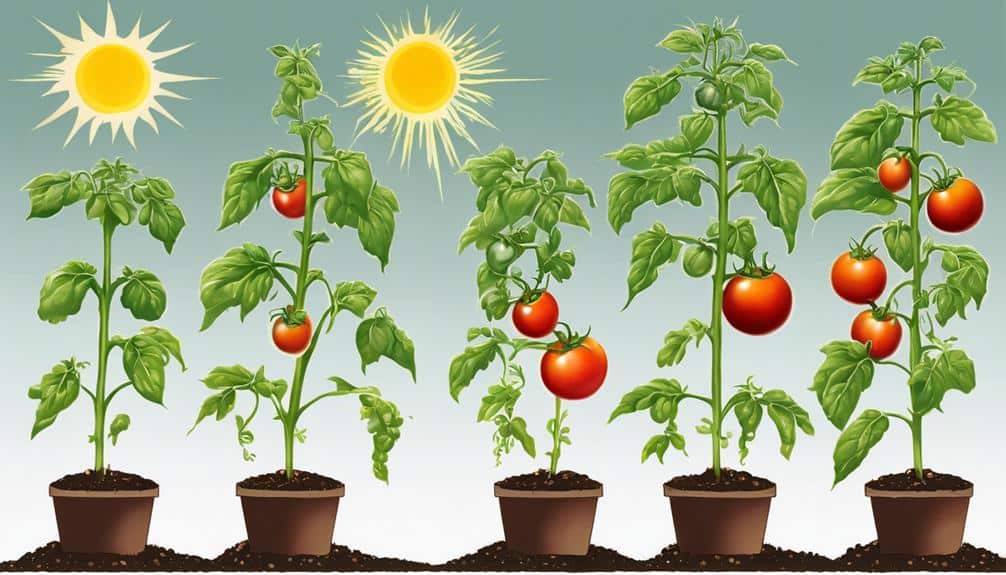
As you grow tomatoes, you'll want to adjust their sunlight exposure according to their growth stage. During the seedling stage, you'll need to provide gentle morning sun to promote healthy development.
Later, you'll need to balance morning and afternoon sunlight to meet the increasing energy demands of the early fruiting and ripening stages.
Seedling Stage Needs
During the seedling stage, you'll want to provide your tomato seedlings with at least 6-8 hours of direct sunlight daily to establish strong roots and promote healthy growth. Adequate sunlight during this stage is essential for developing sturdy stems and leaves. Insufficient sunlight can lead to leggy plants that are more prone to disease and pest issues.
Here are some key considerations for providing ideal sunlight to your seedlings:
- Duration: Make sure your seedlings receive at least 6-8 hours of direct sunlight daily.
- Gradual Acclimation: Gradually acclimate your seedlings to direct sunlight to prevent sunburn and stress.
- Consistency: Provide steady sunlight exposure to help seedlings build resilience.
- Timing: Start providing direct sunlight from the early stages to promote healthy growth.
Early Fruiting Stage
To optimize flower and fruit production, you'll need to provide your tomato plants with a minimum of 6 hours of direct sunlight daily during the early fruiting stage. This stage is critical for setting flowers and developing fruit, and inadequate sunlight can lead to poor fruit set and development, ultimately affecting your harvest.
In fact, research shows that providing 8 or more hours of direct sunlight daily during this stage can enhance fruit quality and quantity.
During the early fruiting stage, tomato plants heavily rely on sunlight to support essential processes like photosynthesis and energy production. Without sufficient sunlight, your plants may struggle to produce the energy they need to grow and thrive.
Ripening Stage Demands
You'll find that the ripening stage presents a unique set of sunlight requirements, differing noticeably from those of the early fruiting stage. As you navigate the ripening stage, you'll want to adjust your approach to promote the best growth and flavor development.
Here are some key considerations for the ripening stage:
- Partial shade aids ripening: Planting tomatoes in spots with partial shade can actually assist in the ripening process of the fruits.
- Balance sun exposure: Balancing sun exposure is essential during the ripening stage to promote the best growth and flavor development.
- Ideal temperatures matter: Sunlight during the ripening stage impacts pigment production, with ideal temperatures for this process being 70-75 degrees Fahrenheit.
- Shade can speed up ripening: Moving potted tomatoes to shade can actually help them ripen faster, as they mature faster in the absence of sunlight.
Vegetative Stage Light Requirements

Providing at least 6 hours of direct sunlight daily is essential for your tomato plants' healthy growth and development during the vegetative stage. During this stage, your tomato plants need a minimum of 6 hours of direct sunlight to support healthy growth and development. In fact, indeterminate tomato varieties require 6-8 hours of sun exposure daily to guarantee robust vegetative growth.
| Stage | Light Requirements |
|---|---|
| Vegetative | 6-8 hours direct sunlight |
| Vegetative (indeterminate) | 6-8 hours direct sunlight |
| Vegetative (insufficient) | < 6 hours direct sunlight |
| Vegetative (optimal) | 8 hours direct sunlight |
| Vegetative (minimum) | 6 hours direct sunlight |
Light energy during the vegetative stage aids in photosynthesis, providing your plant with essential nutrients for thriving. Inadequate sunlight during the vegetative phase can result in weak vines and hinder the overall quality of the plant. Proper sun exposure during the vegetative stage is vital for setting the foundation for a successful tomato plant and future fruit production. By providing your tomato plants with the necessary light requirements, you'll be well on your way to growing healthy, thriving plants that will produce an abundance of delicious fruit.
Flower and Early Fruit Stage Needs

As you shift to the flower and early fruit stage, it's crucial to provide your tomato plants with the right amount of sunlight. You'll need to make sure they receive full sun exposure, as anything less can hinder healthy flower production and fruit development.
Full Sun Exposure
During the flower and early fruit stage, tomato plants require full sun exposure, defined as at least 6-8 hours of direct sunlight daily, to fuel ideal growth and development. You want to make sure your tomato plants receive adequate sunlight during this stage, as it's essential for photosynthesis, flower formation, and setting early fruits.
Here are four key benefits of providing full sun exposure during the flower and early fruit stage:
- Boosts photosynthesis: Adequate sunlight enables tomato plants to produce energy, promoting healthy growth and development.
- Enhances flower formation: Full sun exposure triggers the formation of flowers, which eventually develop into fruits.
- Sets early fruits: Direct sunlight helps set early fruits, ensuring a healthy start for your tomato plant.
- Lays the foundation for a fruitful harvest: By providing the recommended amount of sunlight, you'll set the stage for robust tomato plants and abundant fruit production later in the season.
Shade Tolerance
You'll often find that even with a full sun requirement, tomato plants in the flower and early fruit stage can still benefit from some shade, particularly in hot climates where intense sunlight can be detrimental. This is where shade tolerance comes into play.
While tomatoes need at least 6 hours of direct sunlight daily for best growth and fruit set, insufficient sunlight during this stage can lead to poor flowering, affecting fruit development and overall yield. However, partial shade can be beneficial, especially in hot climates.
Morning sunlight exposure is essential for providing the necessary energy for flowering and fruit production. Balancing sun exposure is essential to secure healthy growth and successful fruit development during the flower and early fruit stage of tomatoes.
To achieve maximum growth, tomato plants require a delicate balance of sunlight and shade. By understanding the importance of shade tolerance, you can provide your tomato plants with the ideal conditions for growth, even in areas with intense sunlight.
Ripening Stage Sunlight Demands

When ripening tomatoes, one must understand that sunlight isn't the driving force behind the process, unlike what you might expect. In fact, tomato fruits don't require sunlight for ripening, as the process is triggered by heat and ethylene gas, not sunlight. This is an important distinction to make, as it can greatly impact your approach to growing and harvesting tomatoes.
To optimize the ripening stage, consider the following:
- Shaded areas are ideal: Fastest ripening of tomatoes occurs in the absence of sunlight, making shaded areas ideal for this stage.
- Balance sun exposure: Balancing sun exposure during the ripening stage is essential to prevent issues like sunscald, cracking, and uneven ripening.
- Move potted tomatoes to shaded spots: Moving potted tomatoes to shaded spots can aid in controlling the ripening process more easily than those planted in the ground.
- Opt for partial shade: Planting tomatoes in areas with partial shade can help optimize the ripening process while ensuring overall plant health.
Balancing Sunlight and Heat Stress
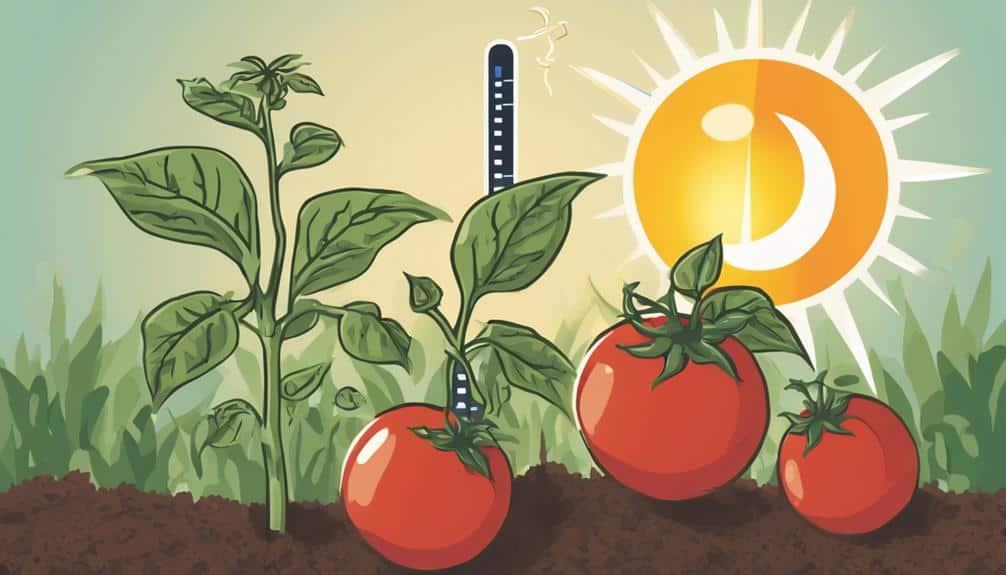
By managing the amount of sunlight your tomato plants receive, you can prevent heat stress and promote healthy growth, especially in warm climates. Tomato plants require a minimum of 6-8 hours of full sun daily to thrive and produce quality fruits. However, excessive sunlight exposure can lead to heat stress, sunscald, and reduced yields. To strike a balance, it's important to monitor sunlight levels and adjust the plant's positioning accordingly.
Providing morning sun exposure can help your tomato plants photosynthesize efficiently without facing intense midday heat. This strategy allows your plants to absorb the necessary sunlight for growth without succumbing to heat stress. Additionally, adjusting the plant's orientation can help mitigate the risk of sunscald, which can cause fruit damage and discoloration.
As a tomato grower, it's crucial to be mindful of the delicate balance between sunlight exposure and heat stress. By keeping a close eye on sunlight levels and making adjustments as needed, you can create an ideal growing environment for your plants.
Using Reflected Light Strategically
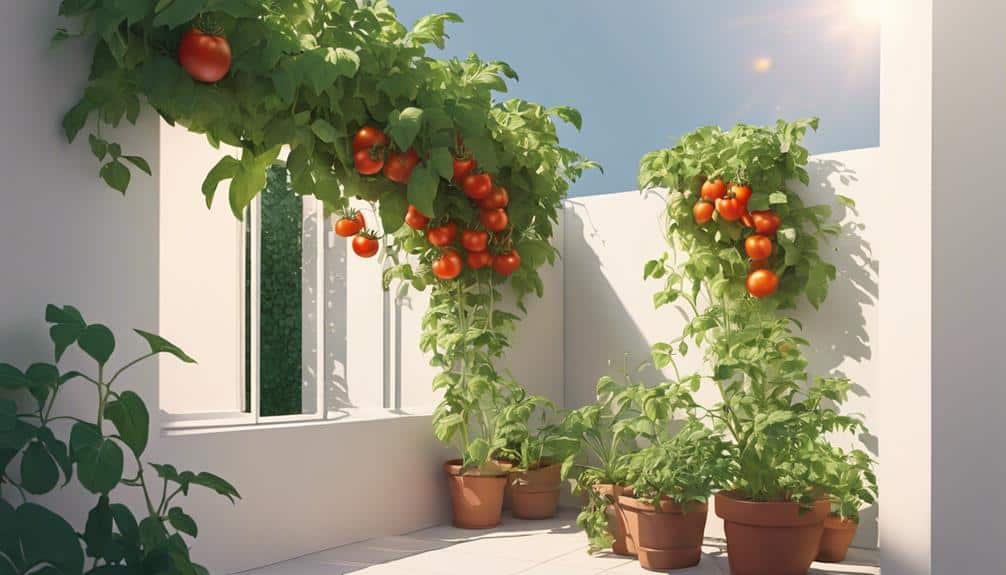
Frequently, clever growers utilize reflected light to boost sunlight exposure for their tomato plants, amplifying energy absorption and promoting healthy growth. By strategically positioning reflective surfaces, you can redirect and amplify sunlight to reach lower leaves and branches, optimizing energy absorption.
Here are some ways to utilize reflected light strategically:
- Redirect sunlight with aluminum foil: Place aluminum foil on the north or east side of your tomato plants to reflect sunlight and increase exposure.
- Use white surfaces to amplify light: Paint walls or surfaces with a white, reflective finish to bounce sunlight onto your tomato plants.
- Enhance light distribution with mirrors: Position mirrors strategically to redirect sunlight and increase light intensity for your tomato plants.
- Optimize light distribution with shiny objects: Place shiny objects, like metal or plastic surfaces, near your tomato plants to redirect and amplify sunlight.
Monitoring Sunlight for Optimal Results
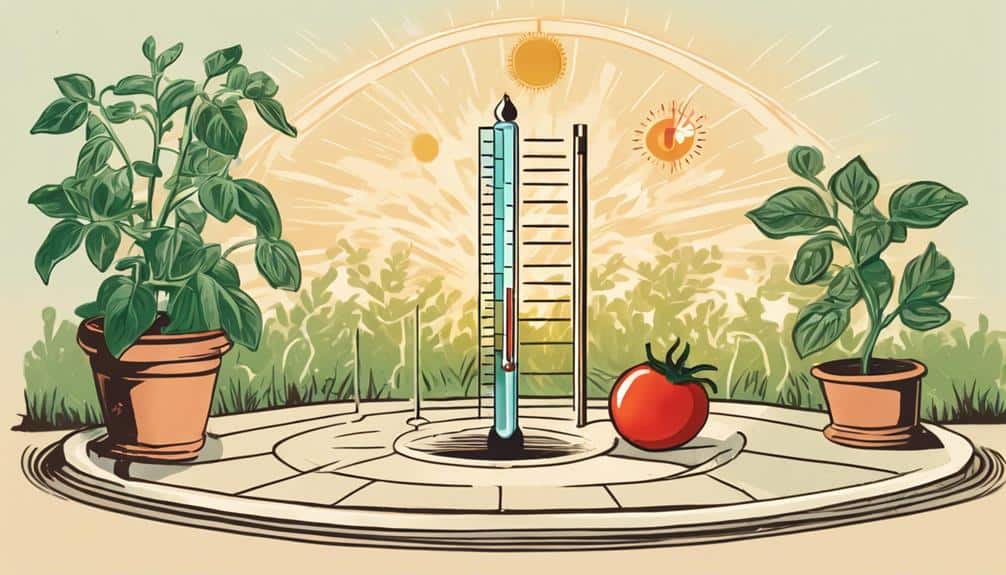
To guarantee that your tomato plants receive the necessary sunlight for best growth and fruit production, you must regularly monitor sunlight levels throughout the growing season. This is important because tomatoes need at least 6-8 hours of full sun daily to thrive and produce abundant fruit. Monitoring sunlight levels ensures that your plants receive adequate sun exposure, which is vital for peak growth and fruit production.
Insufficient sunlight can lead to stunted growth, reduced fruit yield, and overall poor plant health. That's why it's crucial to regularly check on the amount of sunlight your plants are receiving. You can do this by observing the area where your tomato plants are situated, taking note of any obstacles that might be blocking sunlight, and adjusting their position accordingly.
Overestimating sun exposure can also impact plant size and fruit yield, underscoring the need for consistent monitoring of sunlight levels. By doing so, you can identify areas that receive insufficient sunlight and take corrective measures to ensure your plants receive the necessary sunlight for best growth and fruit production.
Can I Grow Tomatoes Indoors Without Sunlight for My Podcast Studio?
Yes, you can start a podcast for free and still grow tomatoes indoors without sunlight. You can use grow lights or LED lights to simulate natural sunlight and provide the necessary light spectrum for the tomatoes to thrive. Just make sure to monitor the temperature and humidity levels for optimal growth.
Is it Safe to Eat Tomatoes That Have Been Exposed to Radiation?
Yes, it is safe to eat tomatoes that have been exposed to radiation, such as getting rid of radiation after a CT scan. The radiation levels used for food preservation are much lower than those used for medical procedures. Therefore, the tomatoes would not pose any risk to your health.
Frequently Asked Questions
Do Tomatoes Like Morning or Afternoon Sun?
You're wondering if tomatoes prefer morning or afternoon sun. The answer lies in balancing both.
Morning sun provides high-intensity light ideal for photosynthesis and growth, while afternoon sun offers warmth, extending the daily energy cycle.
Aim for a balance between the two, ensuring your tomatoes receive adequate sunlight throughout the day.
Proper orientation from east to west is key to maximizing sunlight exposure for best growth and fruit production.
Can Tomato Plants Get Too Much Sun?
You're probably wondering, can tomato plants get too much sun?
The answer is a resounding yes! In fact, it's like drowning them in a sea of sunlight – too much of a good thing can be detrimental. Excessive sun exposure can lead to sunscald, fruit cracking, and uneven ripening.
Can Tomatoes Grow in Part Shade?
You can grow tomatoes in partial shade, but be prepared for slower growth and fewer fruits.
While they can tolerate shade, tomatoes thrive in full sun, ideally receiving 6-8 hours of direct sunlight daily.
If you're limited to partial shade, consider using reflective surfaces or light-colored walls to maximize light exposure.
Balance is key, as too little sunlight hinders growth, but too much can be detrimental.
Do Tomatoes in Pots Like Full Sun?
As you tend to your potted tomatoes, remember that they're akin to ancient Greeks worshiping Helios – they crave sunlight!
You should give them the full sun treatment, just like a Renaissance artist seeking ideal illumination.
Placing them in areas with unobstructed sunlight will fuel their growth, ensuring you reap a bountiful harvest.
Aim for at least 6-8 hours of direct sunlight daily to realize their full potential.
Conclusion
You've made it this far, congrats! Now you know tomatoes need a ridiculous amount of sun – like, a lot.
We're talking 6 hours of direct sunlight daily, with some afternoon shade to prevent heat stress.
Don't even get me started on reflected light; it's like they're trying to get a tan or something. Seriously though, get it right and you'll be enjoying juicy, ripe tomatoes in no time.
Get it wrong, and you'll be left with a bunch of sad, sun-deprived plants. The choice is yours.
